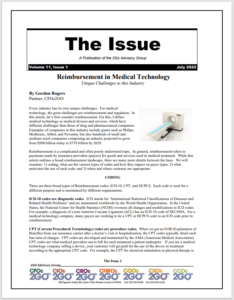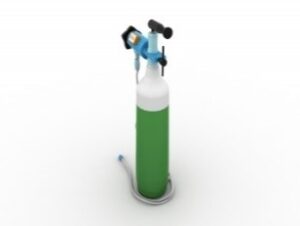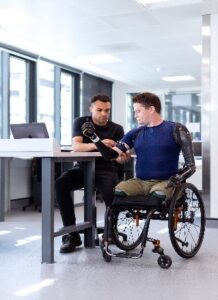 REIMBURSEMENT IN MEDICAL TECHNOLOGY
REIMBURSEMENT IN MEDICAL TECHNOLOGY
Unique Challenges to this Industry
By Gordon Rogers

Every industry has its own unique challenges. For medical technology, the great challenges are reimbursement and regulation. In this article, let’s first consider reimbursement. For this, I define medical technology as medical devices and services, which have different challenges than those of drug and pharmaceutical companies. Examples of companies in this industry include giants such as Philips, Medtronic, Abbot, and Novartus, but also hundreds of small and medium-sized companies comprising an industry projected to grow from $500 billion today to $719 billion by 2029.
 Reimbursement is a complicated and often poorly understood topic. In general, reimbursement refers to payments made by insurance providers (payers) for goods and services used in medical treatment. While this article outlines a broad reimbursement landscape, there are many more details between the lines. We will examine: 1) coding, what are the various types of codes and how they impact on payer types; 2) what motivates the use of each code; and 3) when and where contracts are appropriate.
Reimbursement is a complicated and often poorly understood topic. In general, reimbursement refers to payments made by insurance providers (payers) for goods and services used in medical treatment. While this article outlines a broad reimbursement landscape, there are many more details between the lines. We will examine: 1) coding, what are the various types of codes and how they impact on payer types; 2) what motivates the use of each code; and 3) when and where contracts are appropriate.
CODING
There are three broad types of Reimbursement codes: ICD-10, CPT, and HCPCS. Each code is used for a different purpose and is maintained by different organizations.
ICD-10 codes are diagnostic codes. ICD stands for “International Statistical Classifications of Diseases and Related Health Problems” and are maintained worldwide by the World Health Organization. In the United States, the National Center for Health Statistics (NCHS) oversees all changes and modifications to ICD codes. For example, a diagnosis of a torn Anterior Cruciate Ligament (ACL) has an ICD-10 code of S83.509A. For a medical technology company, many payers are working to tie a CPT or HCPCS code to an ICD code prior to reimbursement.
CPT (Current Procedural Terminology) codes are procedure codes. When we get an EOB (Explanation of Benefits) from our insurance carrier after a doctor’s visit or hospitalization, the CPT codes typically detail each line item of charges. CPT codes are developed and maintained by the AMA (American Medical Association). CPT codes are what medical providers use to bill for each treatment a patient undergoes. If you are a medical technology company selling a device, your customer will get paid for the use of the device in treatment according to the appropriate CPT code. For example, the CPT for electrical stimulation in physical therapy is 97032. The reimbursement for this code is $17 to $23 for each 15-minute increment. So, a PT clinic performing four treatments a day could receive $68 to $92 per day reimbursement. This needs to factor into the pricing and potential use of (in this case) electrical stimulation technology.
HCPCS (Healthcare Common Procedure Coding System – pronounced “hick picks”) codes are used to bill services. HCPCS codes are used by Medicare and maintained by CMS (the Centers for Medicare and Medicaid Services). All insurers follow Medicare’s lead in HCPCS codes. HCPCS II codes are for non-physician services. They represent supplies, devices, and non-physician services not covered by CPT codes. A big use of HCPCS is for DME’s (Durable Medical Equipment suppliers). A DME will sell or rent equipment to a patient in the patient’s home and then bill insurance according to a HCPCS code. For example, a portable liquid oxygen system will have a HCPCS code of E0435. Rental of a portable liquid oxygen system will reimburse between $34 and $49 per day.
Coding is complex and varies greatly according to the patient diagnosis and the provider. Medical technology companies need to be very careful not to be seen as promoting the use of codes by third parties. Several cases exist of prosecution for Medicare fraud among other violations due to “code chasing” (submitting a code which does not accurately match the diagnosis to get greater reimbursement). While companies may want to provide examples of potential codes and how they may be used, the company must also provide a disclaimer that they are not making coding decisions or recommendations. The approach to giving advice to healthcare providers requires very cautious and well reasoned discussions.
PAYERS
When most of us think of medical insurance carriers, we think of large commercial insurance carriers such as Blue Shield or United Healthcare. In fact, while this makes up two thirds of all payments in the United States, several other highly valuable categories of payers exist. Understanding these payers and their motives will help focus medical technology companies’ sales strategy.
Commercial Payers
Commercial Payers, such as Blue Cross, Blue Shield, Kaiser, Aetna, United Health Care and others make up the majority of health payments in the United States. Since the advent of the Affordable Care Act, these insurers have had to be more conforming in what they offer to their clients. From the standpoint of a medical technology company, insurers appear to have a business model of “Collect Premiums, Deny Claims”. Their motivation seems to be to find reasons to delay or deny claims, and to pay providers as little as possible. Often, a provider must submit additional paperwork or explanations to get paid and, of course, just because a provider requests payment of $X doesn’t mean that they will receive this. Payers often “discount” significantly from their published rates.
For an unestablished product, a medical technology company using a miscellaneous “investigational” HCPCS E1399 code, gaining reimbursement can be a long and difficult process. Most commercial carriers automatically deny an E1399 code as “investigational”. The provider can fight back against the denial by filing an appeal with a “Letter of Medical Necessity” from the prescribing physician. Typically, what will happen next is that the payer’s in house medical practitioner will evaluate the necessity of the claim and then approve (rare) or deny (more common) the prescribing physician’s rationale. Further appeals may be attempted where additional information is presented to gain reimbursement. The best weapons in this case are clinical and economic evidence of the effectiveness of the treatment. In addition, not all commercial insurance is the same. There are PPO’s, HMO’s, High-Deductible Plans with Healthcare Spending Accounts, and so called Cadillac plans. Each of these categories will require a different approach to reimbursement with HMO’s being very difficult to gain reimbursement and Cadillac plans being easier. A challenge for a provider is that they may not know what codes are reimbursable under a patient’s plan until the claim is submitted – prequalifying prior to dispensing is difficult.
For a MedTech company, identifying a valid CPT code helps payers reimburse a procedure using their device.
Government
 Medicare and Medicaid pay only according to established codes and often pay at a lower rate than commercial payers. Their motivation is adherence to statutes and schedules. Therefore, there is constant budget pressure on MedTech providers resulting from increased scrutiny and reductions in reimbursement in the United States for all government insurance programs.
Medicare and Medicaid pay only according to established codes and often pay at a lower rate than commercial payers. Their motivation is adherence to statutes and schedules. Therefore, there is constant budget pressure on MedTech providers resulting from increased scrutiny and reductions in reimbursement in the United States for all government insurance programs.
Where a medical technology company can use an established CPT When a company will need to use a HCPCS code, such as using a medical device for in- home treatment post-surgery, Medicare and Medicaid will often not reimburse.
Private Pay
Some patients either do not have insurance or are willing to pay out of their own pocket for treatments and equipment they desire. For these patients, money is less of an issue than relief and convenience. This can be a lucrative albeit relatively small sub-population. Witness the multi-billion-dollar aesthetics industry which is all private pay. Medical technology companies can price their product at a cost people find affordable and of good value which they purchase outright with their doctor’s prescription, creating a viable business.
TriCare
The United States Military provides medical insurance for almost 10 million active duty, and retired personnel and their dependents. The motivation for Tri Care is similar to Workers Comp in that Tri Care wants to get their soldiers back to active duty – though the urgency can actually be higher as an injured soldier can affect an entire unit. Tri Care is divided into two regions – TriEast and TriWest, each of which is administered independently.
Auto / Personal Injury
All of us have personal injury insurance as a part of our automobile insurance. When we are injured in an auto accident, the insurer wants to take good and rapid care of the injured party to fend off more expensive litigation. Auto / Personal Injury can be a lucrative area for medical technology companies. This is a small market though and can be very slow paying when the claims get tied up in litigation.
Workers Compensation
 Workers compensation is a potentially large and lucrative business with almost $62 billion in benefits paid annually. For a work comp insurer to show a profit, it must get a patient / employee back to work as quickly as possible as they pay for lost wages as well as treatment. Thus, they are often willing to reimburse at a premium rate and pay extra, even for “investigational” E1399 devices, if they can be convinced the patient will cycle off of insurance quicker. For a patient using the company’s products as home therapy, this could be a very promising area. The work comp landscape is very complex though. Each state has its own work comp laws, with some opting for taxpayer -supported state funds and others putting all work comp in the hands of private employers. Many states have a mix of both. In addition, more states are adopting ODG (Occupational Disability Guidelines) for workers comp. These are treatment guidelines which might effectively limit the use or duration of a treatment. Professional athletes who get injured are generally covered under very generous, company-sponsored, workers compensation plans, making this a potentially lucrative market for medical technology company.
Workers compensation is a potentially large and lucrative business with almost $62 billion in benefits paid annually. For a work comp insurer to show a profit, it must get a patient / employee back to work as quickly as possible as they pay for lost wages as well as treatment. Thus, they are often willing to reimburse at a premium rate and pay extra, even for “investigational” E1399 devices, if they can be convinced the patient will cycle off of insurance quicker. For a patient using the company’s products as home therapy, this could be a very promising area. The work comp landscape is very complex though. Each state has its own work comp laws, with some opting for taxpayer -supported state funds and others putting all work comp in the hands of private employers. Many states have a mix of both. In addition, more states are adopting ODG (Occupational Disability Guidelines) for workers comp. These are treatment guidelines which might effectively limit the use or duration of a treatment. Professional athletes who get injured are generally covered under very generous, company-sponsored, workers compensation plans, making this a potentially lucrative market for medical technology company.
Third Party Administrators (TPA’s) are consolidators of workers compensation claims. They will service a claim, pulling together the multitude of suppliers and managing all treatments and payments. High quality established TPA’s generally pay less than direct workers comp insurers but may lead to higher volumes and tend to be more prompt payers.
Contracts
Despite the lack of a code, it may be possible to work with specific insurers and enter into a separately negotiated contract. The advantage of a contract is that the claim will be treated as a covered, in network service, despite the lack of a code, and the claim may be submitted electronically. Rates will be set under contracts, and while they may be somewhat lower than could be realized otherwise, payment will be faster and more consistent. Contracting directly with TPA’s is an excellent method to effectively prosecute the Workers Comp market as they will work with medical technology companies under contract to promote the company’s technology.
CONCLUSIONS
Both nuance and detail still lie between the lines of this article. To put together a sales and marketing strategy which fully prioritizes markets for MedTech companies to pursue requires careful work and analysis beyond this high-level reimbursement overview. Medical technology companies should examine the market potential for Hospital, Home Health, Physical Therapy, Athletic Trainers, Post Op Recovery, Long Term Care, Chiropractic and others along with the respective reimbursement implications.
We are happy to provide our valuable expertise to assist medical technology companies in developing their growth strategies. Feel free to contact me to answer any questions you may have, with the contact information below.
I will address the regulatory environment in the United States in a future article as well.
 Gordon L. Rogers recently joined the 2Go Advisory Group in their Health and Life Science Practice Area. He brings a wealth of experience spanning all facets of business from manufacturing to sales and corporate affairs, and has significant international experience. Much of his career was in medical technology.
Gordon L. Rogers recently joined the 2Go Advisory Group in their Health and Life Science Practice Area. He brings a wealth of experience spanning all facets of business from manufacturing to sales and corporate affairs, and has significant international experience. Much of his career was in medical technology.
![]()
